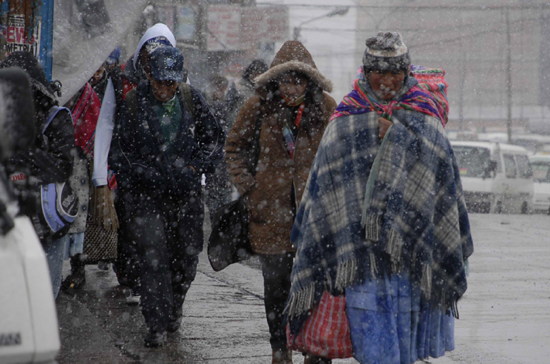
(above) Residents of El Alto, Bolivia, struggle in cold weather. (EPA)
Heavy snow brings Bolivia to a halt
July 12, 2011 - Aljazeera.net
Heaviest snow in 20 years blocks roads and threatens agriculture and alpaca and llama herds in Andean nation.
The cold winter weather which has affected much of South America is making its presence felt in Bolivia, after the heaviest snowfall in 20 years brought parts of the country to a standstill.
Cold southerly winds, known as ‘surazos’ by local people, have brought the largest falls to the southwest Potosi region. The snow has blocked roads cutting off many rural communities.
This region relies on agriculture and farmers report that crops have been destroyed and many herds of alpacas and llamas are struggling to find food below the snow cover.
Bolivia has appealed for help from neighbouring countries, requesting helicopters to help drop supplies to those cut off by the snow. The government has only two helicopters of its own.
The harsh winter being experienced by much of central and southern South America is consistent with the current La Nina event. (The cold upwelling of ocean waters off the west coast.)
Although La Nina is weakening, its presence is likely to continue the threat of further harsh weather in the remaining winter months. At least 30 people are known to have died of hypothermia in the capital, La Paz and El Alto.
In recent weeks there have been rarely seen falls of snow in neighbouring Argentina. Concerns have also been raised about the potential damage done by the cold weather to Brazil’s future coffee production – the country is the world’s largest coffee producer.
Snow is not expected over the next few days. In fact, sunny skies should see any helicopter relief efforts go unhindered by the weather.
But as a side effect of the snow, which acts like a blanket, insulating the ground, night-time temperatures are likely to fall below minus 10 degrees Celsius, limiting the extent of any thaw.